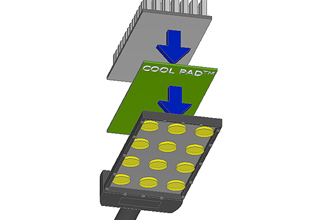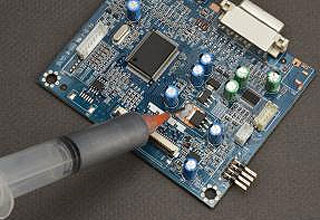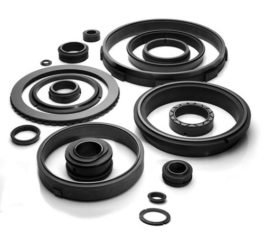AI Technology, Inc. (AIT) introduces COOL-PAD™ CPR7154, a new class of thermal interface material that dispenses like a thermal pad, but performs with characteristics like that of a grease or gel when device temperatures increase to above 45°C. COOL-PAD™ CPR7154 is optimized to accommodate large areas with different heights and gaps of less than 3-mil…
How to Secure Fasteners and Strengthen Interference Fits
By Doug Lescarbeau, Anaerobic Technology Manager, and Tina Adams, OEM Market Manager, Henkel Corporation Retaining compounds offer a number of benefits in fastening applications, including reducing weight, lowering cost and assembly time, and even reducing some dimensional precision requirements. Here’s a closer look at when and how you can use retaining compounds. Ancillary benefits of…
Rogers Corp Launches Coolspan Thermally & Electrically Conductive Adhesive Film
Rogers Corporation (NYSE: ROG) Advanced Circuit Materials Division launched COOLSPAN® Thermally & Electrically Conductive Adhesive (TECA) Film providing reliable high temperature performance. COOLSPAN TECA Film is a thermosetting, epoxy based, silver filled adhesive film used to bond circuit boards to heavy metal backplanes, heat sink coins and RF module housings. The adhesive can be used…
Flexible Epoxy System Features Electrical and Thermal Conductivity
Formulated with a silver coated nickel filler, Master Bond EP79FL is a two part, electrically conductive epoxy for bonding, sealing and coating applications. It has low volume resistivity of less than 0.005 ohm-cm and is suitable for a variety of uses in the electronic, aerospace, computer, semiconductor and electro-optic industries. In addition to its electrical…
Critical Sealing, Wear Resistance And Long Operating Life
Critical sealing applications in vehicles call for high performance plastics custom designed and molded by Minnesota Rubber and Plastics. Transmission oil seals are a challenge to manufacture for heavy duty vehicles including city buses, garbage and dump trucks. Long and rugged service life for oil seal assemblies in these vehicles is required because they are…
Saint-Gobain Supplies OmniSeal® and Rulon®
The Saint-Gobain Seals Group was recently selected to supply OmniSeal® spring-energized seals and Rulon® bearings for use in high-performance clinical chemical analyzer systems. Chemical analyzers are used in a variety of professions such as medicine and forensics and in such industries as environmental, pharmaceutical, cosmetics, agricultural, consumer products, and food and beverage. In large routine…
Freudenberg-NOK on Board the Bombardier CSeries Aircraft First Flight
Freudenberg-NOK Sealing Technologies Simrit (Freudenberg-NOK) is proud to have been on board the Bombardier* CSeries* aircraft as it completed its first flight. Freudenberg-NOK supplied various sealing components to the aircraft’s airframe and engine system. From the airframe to the engine propulsion systems, Bombardier’s CSeries aircraft represents some of the most advanced technology and we’re honored…
Two-part Production Simplifies Medical Designs
by Mary C. Gannon, Senior Editor Two years ago, Trelleborg Sealing Solutions purchased a liquid silicone company headquartered in Switzerland, which provided silicone extrusion and silicone molding, all in a clean room facility. The facility in Stein am Rhein, Switzerland and another in Northborough, Mass., allows the company to manufacture and design two-part Liquid Silicone…
Metcar Announces Mechanical Seal Primary Rings
Metallized Carbon Corporation announces the availability of mechanical seal primary rings for sealing refrigerants and other low viscosity liquids. Designing mechanical seals for sealing refrigerants and other low viscosity liquids has been a difficult problem for seal manufactures for many years. It has now been established that mechanical seals with antimony impregnated, carbon-graphite primary rings and…
Quartz Filled Two Component Epoxy Features High Temperature and Chemical Resistance
Master Bond Supreme 45HTQ is a thermally stable, two component quartz filled epoxy system. It features exceptional abrasion and chemical resistant properties. It will withstand exposure to petrochemicals, acids, bases and solvents. It retains its performance profile at elevated temperatures up to +450°F. Supreme 45HTQ has a 100 to 30 mix ratio by weight and…










